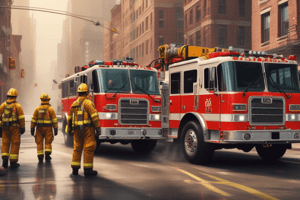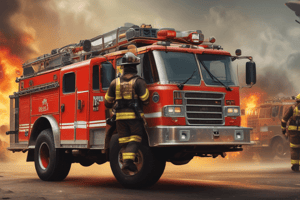Podcast
Questions and Answers
What should the first arriving officer do when evaluating the situation?
What should the first arriving officer do when evaluating the situation?
- Immediately initiate an offensive attack
- Wait for backup before making any decisions
- Implement the NFPA 1500 risk management process (correct)
- Focus on securing personal safety first
When should risk/benefit analysis be assessed?
When should risk/benefit analysis be assessed?
- When command is established
- Only during the initial attack
- After major tactical objectives are achieved (correct)
- At the end of the operation
What is essential during the transition from offensive to defensive attack?
What is essential during the transition from offensive to defensive attack?
- Conducting a secondary size-up
- Firm command and control of the operation (correct)
- Immediate evacuation of all firefighters
- Deployment of master streams for offensive attack
What is primarily used in defensive attacks?
What is primarily used in defensive attacks?
What is the primary consideration for conducting defensive attacks?
What is the primary consideration for conducting defensive attacks?
What is the recommended tactic for protecting internal exposures in defensive mode?
What is the recommended tactic for protecting internal exposures in defensive mode?
What does the energy levels for radiant heat depend on?
What does the energy levels for radiant heat depend on?
When is applying water directly on exposed structures considered the best tactic?
When is applying water directly on exposed structures considered the best tactic?
What is the primary consideration in placing exterior streams?
What is the primary consideration in placing exterior streams?
What type of attack is people intensive?
What type of attack is people intensive?
When is a solid stream best suited according to the text?
When is a solid stream best suited according to the text?
What does the term 'conflagration' refer to in an urban setting?
What does the term 'conflagration' refer to in an urban setting?
What are common contributing factors in urban conflagrations?
What are common contributing factors in urban conflagrations?
What is the primary means of fire extension from building to building as the flame front widens?
What is the primary means of fire extension from building to building as the flame front widens?
Who is typically the best agency to manage the evacuation during a conflagration?
Who is typically the best agency to manage the evacuation during a conflagration?
What is the first step in developing a conflagration strategy?
What is the first step in developing a conflagration strategy?
Why are nonattack postures underused?
Why are nonattack postures underused?
What is the primary damage?
What is the primary damage?
When is property conservation generally considered no longer an issue?
When is property conservation generally considered no longer an issue?
How does the proper application of larger than needed hose streams affect water damage?
How does the proper application of larger than needed hose streams affect water damage?
What is a recommended action to reduce water damage?
What is a recommended action to reduce water damage?
What does removing a toilet create?
What does removing a toilet create?
What should be ensured before sending personnel into a confined space containing standing water?
What should be ensured before sending personnel into a confined space containing standing water?
What is the purpose of overhaul in firefighting?
What is the purpose of overhaul in firefighting?
When can property conservation activities be assigned?
When can property conservation activities be assigned?
Flashcards are hidden until you start studying
Study Notes
Initial Response and Risk Assessment
- The first arriving officer should evaluate the situation to determine the best course of action.
- Risk/benefit analysis should be assessed to determine the potential risks and benefits of different actions.
Defensive Attack Strategies
- During the transition from offensive to defensive attack, it is essential to have a clear understanding of the situation and to prioritize safety.
- Defensive attacks are primarily used to protect exposures and prevent fire spread.
- The primary consideration for conducting defensive attacks is to protect people and property.
- The recommended tactic for protecting internal exposures in defensive mode is to use a remotely operated monitor or a large-caliber hose stream.
Water Application and Stream Placement
- The energy levels for radiant heat depend on the distance from the fire and the size of the flames.
- Applying water directly on exposed structures is considered the best tactic when the fire is not too large and the structure is not too heavily involved.
- The primary consideration in placing exterior streams is to take into account the wind direction, flame height, and location of the fire.
Conflagration Response and Strategy
- A conflagration in an urban setting refers to a large, uncontrolled fire that spreads quickly from building to building.
- Common contributing factors in urban conflagrations include strong winds, dry conditions, and closely spaced buildings.
- The primary means of fire extension from building to building as the flame front widens is through radiant heat and embers.
- The fire department is typically the best agency to manage the evacuation during a conflagration.
- The first step in developing a conflagration strategy is to identify potential fire spread routes and prioritize resource allocation.
Property Conservation and Overhaul
- Nonattack postures are often underused due to the potential for property damage.
- The primary damage in a fire is usually caused by water and smoke.
- Property conservation is generally considered no longer an issue when the fire is under control and the structure is safe to enter.
- The proper application of larger-than-needed hose streams can increase water damage.
- A recommended action to reduce water damage is to use a smaller hose stream and to apply water only where necessary.
- Removing a toilet can create a pathway for water to flow into adjacent areas.
- Before sending personnel into a confined space containing standing water, it should be ensured that the water is safe to enter and that the necessary precautions are taken.
- The purpose of overhaul in firefighting is to search for and extinguish any remaining hotspots or hidden fires.
Studying That Suits You
Use AI to generate personalized quizzes and flashcards to suit your learning preferences.




